Nałęcz coat of arms
| Nałęcz | |
|---|---|
 | |
| Details | |
| Battle cry | Nałęcz, Nałęcz Jezioro |
| Alternative names | Choczennica, Łęczuch, Nalancz, Nalencz, Nałęczyta, Nałonie, Pomłość, Toczennica, |
| Earliest mention | 1293 (seal), 1398 (record) |
| Families |
933 names Abram, Andrzejewski, Andrzejowski. Babecki, Baczkowski, Badoracki, Baranowski, Batycki, Bączkowski, Bąklewski, Beklewski, Bendoński, Benglewski, Benklewski, Berski, Berzbortkiewicz, Bethune, Będoński, Bęklewski, Białłyszewski, Białowieski, Bielakowski, Bielański, Bielejewski, Bierwecki, Bierzwięcki, Bierżewicki, Bierżewski, Blanday, Błażejewicz, Błędostowski, Błędowski, Błogowski, Błoniewski, Błoniowski, Błoński, Bobolecki, Bobolicki, Bobrowski, Bocianowski, Bodzisławski, Bogdaszewski, Boguchwał, Bohdaszewski, Bojarski, Bolochowiec, Bołchowiec, Bołkoński, Bołochowiec, Bonczakowski, Bonisko, Boniuszko, Borkowski, Borodziński, Borsa, Borsza, Borszowicz, Bortkiewicz, Bortkowicz, Bortkowski, Borzestowski, Borzkowski, Boszkowski, Bratkowski, Brodzki, Brudzewski, Bryndzanacki, Brzański, Brzozdowski, Buczek, Buczko, Bukojemski, Buza, Bużański, Bzowski. Cal, Ciborski, Charbicki, Chawejłowicz, Chełmicki, Chełmiński, Cherubinowicz, Chinowski, Chlebicki, Chłembowski, Chłębowski, Chłopecki, Chmar, Chmara, Chmiel, Chodakowski, Chomiąski, Chomięcki, Chrepkowicz, Chwalibogowski, Chwat, Chynowski, Cichocki, Ciechanowicz, Ciechocki, Ciechowski, Ciepieński, Ciepiński, Conradi, Cwiklicz, Czasoński, Czech, Czeperowski, Czepiński, Czerniewicz, Czołpiński. Ćmachowski, Ćwikliński. Dahlke, Dalkiewicz, Darowski, Dawrowski, Dąbrowski, Debrzyński, Derszniak, Dersztorff, Ditrich, Dłuski, Dmowski, Dobaczewski, Dobrogost, Dobrosławski, Dobrowolski, Dobrzyński, Dołągowski, Dołongowski, Domasławski, Domasłowski, Domaszewski, Domosławski, Domysławski, Donajewski, Donajski, Dorohanicki, Dowgiał, Dowolg, Dowolgo, Drochiński, Drociński, Drohiciński, Drohiczański, Drohiczyński, Drohiński, Droyczewski, Drużbicki, Drużbiński, Drzewiecki, Dubieniecki, Duszyński, Dworczyński, Dwornicki, Dwornik, Dybczyński, Dybowski, Dybek, Dybrzyński, Dylądowski, Dylągowski, Dylengowski, Dylkiewicz, Dzbański, Dzbeński, Dzbiński, Dziećmiarowski, Dzierżykraj, Dziewierzewski, Dziewoński, Dzułay, Dzwonowski, Dżugay, Dżułat, Dżułay. Eńko. Falcz, Fąferek, Felner, Felnerowicz, Filicki, Filipecki, Fortuna. Gajewski, Gartkiewicz, Garwoliński, Gasperowicz, Gawarecki, Gawin, Gawłowski, Gembicki, Gębicki, Gigański, Gilbaszewski, Gimbut, Gimbutowicz, Ginalski, Ginbut, Giżycki, Gliszczyński, Gładki, Głowacz, Głuchowski, Głuzicki, Gnuszyński, Goleszewski, Golian, Golikowski, Goloszewski, Gołębski, Gołoszewski, Gorawski, Gorski, Gorzeński, Gorzycki, Gorzyński, Gosławski, Gostomski, Goszczyński, Gowarecki, Gozdzikowski, Gożewski, Górecki, Górka, Górski, Grabski, Graff, Grąbczewski, Grochala, Grocholski, Grochowalski, Grochowolski, Grodzicki, Grodziecki, Grodziński, Grot, Grzejewski, Grzymisławski, Gulczewski, Gurski. Hanowiecki, Herstopski, Hersztopski, Hłodki, Holibowski, Horaszkiewicz, Horoszkiewicz, Horoszowski, Horski, Horyszewski, Horyszowski, Horztopski, Howryłowski, Hoztopski, Hryniewicz, Hulewicz, Huściłło, Huściło. Idzelewicz, Idzellewicz, Idzikowski, Ilikowski, Iłłowiecki, Iłowicki, Iłowiecki, Imbir, Imbram, Imbramowicz, Imram. Jabłonowski, Jakusz, Jałomowicz,[1] Jałowicki, Jałowiecki, Jamont, Jamontt, Janczewski, Janicki, Janowski, Januszewicz, Jarczewski, Jarczowski, Jargocki, Jargoski, Jarzymski, Jasielski, Jasieński, Jawecki, Jawiecki, Jeleniewski, Jeleński, Jeliński, Jełowicz, Jeńkowicz, Jezierski, Jeżewski, Jeżowski, Jędrychowski, Jędrzejewski, Jędrzejowski, Jędrzychowski, Jędrzyjewski, Jędrzyjowski, Jocher, Jodkowski, Jodłowski, Jotkowski, Juckiewicz, Judkowski. Kaczan, Kaczanowski, Kaczkowski, Kaczyński, Kagan, Kaliński, Kaliszewski, Kaliszkowski, Kalitowski, Kalitwiński, Kamieński, Kampiery, Kaniewiecki, Kaniewski, Kaniowski, Karczewski, Kardaszewski, Karkuszka, Karkuszko, Karłowicz, Karpowicz, Karpowski, Kasinowski, Kawałowski, Kazanecki, Kazański, Każdajlewicz, Kąsinowski, Kembłowski, Kębłowski, Kędzierski, Kęsicki, Kęszycki, Kibeleński, Kielbicki, Kiełbasa, Kietułk, Kissiński, Kiszewski, Klonowski, Kłobicki, Kłobocki, Kłokocki, Kłokowski, Kłonowski, Kobelecki, Kobelnicki, Kobierzycki, Kobylnicki, Kobyłecki, Kocieło, Koczan, Koczanowicz, Koczanowski, Koleński, Koliński, Komornicki, Komorowski, Koniewski, Konradi, Konrady, Kopczyński, Korkuć, Kormanowicz, Koroza, Korycieński, Korzanowicz, Korzenicki, Korzeniecki, Korzeniewski, Korzeniowski, Korzeń, Korzyniewski, Kosinowski, Kostecki, Koszczyński, Kozłowski, Koźmian, Kraskowski, Krasowski, Krassowski, Kraszkowski, Krazan, Krempski, Krępski, Kruchowski, Kruszkowski, Kublewski, Kucewicz, Kuczan, Kulikowski, Kulinkowski, Kunowski, Kupraszewicz, Kurkuć, Kuszycki, Kwaśniewski, Kwiatkowski, Kwieciński. Laband, Labanda, Lachowski, Laszowski, Lauterbach, Lazański, Lebiedziejewski, Ledzeński, Lekczyński, Leński, Lesenko, Lesicki, Lesiecki, Leszczkowski, Leszczyński, Leszkiewicz, Lewandowski, Lewicki, Lewiecki, Lezeński, Leziński, Leźnicki, Leżański, Leżeński, Leżnicki, Leżyński, Lęcki, Lędzki, Lipka, Lippi, Lisieński, Lisowski, Liszak, Lubieński, Lubiński, Lubsiński, Ludicki, Ludzicki, Ludziski, Lwowski. Łagiewnicki, Łakieński, Łakiński, Łakucewicz, Łaszewski, Łaszowski, Łaściszewski, Ławicki, Ławiecki, Łazański, Łażyński, Łączyński, Łąka, Łąkowski, Łążyński, Łekieński, Łęcki, Łędzki, Łękiński, Łękowski, Łokucewicz, Łomnicki, Łoniecki, Łoniewski, Łopacieński, Łopaciński, Łowecki, Łowęcki, Łowicki, Łowiecki, Łowiński, Łubkowski, Łubowski, Łukomski, Łust, Łusta, Łuszczewski, Łuszczowski. Maciurkowski, Mackiewicz, Majewski, Malicki, Malicz, Maliski, Malski, Małachowski, Małyski, Manikowski, Mańkowski, Marcinkiewicz, Marcinkowski, Markowski, Masłowski, Mazurowski, Meszyński, Męszyński, Michalecki, Michalicki, Mickiewicz, Mićkiewicz, Mierzyński, Miesłowicki, Mieszyński, Milanowski, Milkiewicz, Miłachowski, Mitraszewski, Mniski, Modlski, Mogniński, Molski, Monczyński, Montrym, Morawicki, Moszczenicki, Moszczeński, Moszczyński, Moszeński, Moszyński, Mrocki, Mroczkowski, Mrozowski, Mściwojewski, Mściwujewski, Mukiewicz, Mulewski, Muszyński, Mysłowski. Nakielski, Nalaskowski, Nałęcz, Nagórski, Napachański, Napachowski, Nasadowski, Nicki, Niedziałkowski, Niemierza, Niemira, Niemirowicz, Niemiryc, Niemirycz, Niemirzyc, Nienałtowski, Nienieński, Nieniewski, Nieniński, Niepokojczycki, Niesiołowski, Niesłuchowski, Nieświastowski, Nieświatowski, Niewiejski, Niewiński, Ninieński, Niniewski, Niwiński, Nojewski, Norejkowicz, Nosadowski, Nowodworski, Nowokuński, Nowopolski, Nowosielecki, Nowosielski. Obiezierski, Objezierski, Obolewicz, Oborowski, Oborski, Obrzycki, Ochmanowicz, Odachowski, Odechowski, Odrzywolski, Okoński, Okuliński, Okuński, Olkiewicz, Orchowski, Orochowski, Oryszowski, Osiński, Ostropolski, Ostroróg, Ostrowski, Oszczonowski, Ośmiałowski, Ośniałowski, Ożarowski. Padarzewski, Padaszewski, Palenowski, Pancerski, Papuskowski, Parczewski, Parol, Parskliński, Parszchliński, Parszewski, Parul, Parzkliński, Paszkiewicz, Pawłowski, Perowski, Petraszkiewicz, Petrykowski, Pęcherzewski, Pęchorzewski, Piasecki, Piegłowski, Piergowski, Pierski, Pietraszkiewicz, Pietraszko, Pietrusiński, Pigłowski, Pilawski, Pilichowski, Piorowski, Piotrowicz, Piotrowin, Pirgocki, Pirogowski, Pirski, Piruski, Pniewski, Pniowski, Podkocki, Podlecki, Podleski, Podłęcki, Podolak, Podolski, Poklękowski, Polaski, Poleński, Poluchowicz, Połaski, Poławski, Połazki, Popiel, Popielski, Popowski, Poradziński, Porzyński, Post, Posth, Potarzycki, Prusimski, Pruszyński, Przedwieczorski, Przedzyński, Przetecki, Przetocki, Przewoski, Przewóski, Przewuski, Przędzielski, Przędzyński, Przyborowski, Przyborów, Przybysławski, Przyłęcki, Przywieczerzyński, Pulnarowicz, Pułczyński, Putkowski, Pycz, Pyczyński. Raczyński, Radaczyński, Radzicki, Ragowski, Rajewski, Ramatowski, Regacki, Regmont, Regmunt, Rogajski, Rogalski, Rogaski, Rogiński, Rokitnicki, Rokszycki, Rostworowski, Rozwarowski, Rucieński, Ruciński, Rudnicki, Rudziewicz, Rulikowski, Rumbo, Rumbowicz, Rumowski, Runowski, Rusian, Rusiłowicz, Russian, Russyan, Rychłowski. Sachno, Sachnowski, Sadokierski, Sadomski, Sadowski, Sadzyński, Samacki, Sarbski, Sempelborski, Sernicki, Setnicki, Sędywój, Sępiński, Sianożęcki, Siedlecki, Sieprawski, Sierakowski, Sieroszewski, Sierszewski, Sierzchowski, Sietnicki, Sirochowski, Sitański, Sitnicki, Skaławski, Skałecki, Skałocki, Skałowski, Skaryszewski, Skomorowski, Skoś, Skórski, Skrobaczewski, Skubaczewski, Skubaszewski, Sławieński, Sławiński, Słonkowski, Sobieszczański, Sobocki, Socha, Sokolnicki, Sosnowski, Soszyński, Sozański, Sożański, Stadnikiewicz, Staniszewski, Stanowski, Stańczyk, Starczewski, Starogrodzki, Starorypiński, Stasiewicz, Stawiarski, Stempniewicz,Slizewicz, Stromiło, Strumiłło, Strumiłowski, Struś-Kamyszkowski, Sudmont, Sulicki, Suradowski, Suski, Suyski, Swarczewski, Swaryczewski, Swaryszewski, Saryszowski, Swarzyszewski, Sypkowski, Szadokierski, Szadokretski, Szamota, Szamotulski, Szamotuła, Szarogrodzki, Szczekocki, Szczukocki, Szemborski, Szepetowski, Szlagowski, Szubiński, Szujski, Szuyski, Szwaryszowski, Szwarzyszowski, Szyberna, Szymberski, Szymborski, Szymbowski, Szyprowski. Ślęski, Śmietanka, Śnieszek, Śnieszko, Świdwa, Świeprawski. Taplicki, Tarajewski, Tarnawski, Tarnowski, Tessarowski, Tholibowski, Timiński, Tłukomski, Tokbowski, Tolbowski, Tolibowski, Tomasz, Tomkiewicz, Topalski, Toplicki, Topolski, Trawiński, Trzebicki, Trzeyeński, Trzyeński, Tulibowski, Tupalski, Tupolski, Tuskiewicz, Tuszyński, Tymiński, Tynicki, Tyrzyński. Udanowski, Udowicz, Udrycki, Udrzycki, Udzielski, Uhrynowski, Uszak. Wakulewicz, Wardęski, Warszowski, Watkiewicz, Watkowski, Wąsowski, Wąssowski, Wątkiewicz, Wątkowski, Westchowski, Węgier, Wielądka, Wielądko, Wielątkowski, Wielżyno, Wielżyński, Wiencewicz, Wienicki, Wieniecki, Wiennicki, Wierszowski, Wierzbicki, Wierzbiński, Wierzbowski, Wierzchaczewski, Wierzuchowski, Wikowski, Wilga, Wilk, Wilkczycki, Wilkowski, Wilksicki, Wilksycki, Wilkszycki, Wilżyński, Winiecki, Winnicki, Wir, Wisłogórski, Wisłogurski, Witowski, Włyński, Wodecki, Wojchowski, Wojciechowski, Wojnicz, Wojniesławski, Wojno, Wojnowicz, Wojnowski, Wojsławski, Wolański, Wolski, Wołucki, Wołudzki, Woyno, Wójcikowski, Wstowski, Wujcikowski, Wysocki. Zabicki, Zagajewski, Zajączkowski, Zaklikowski, Zakrzewski, Zanszyk, Zarczycki, Zarczyński, Zarszyniski, Zarszyński, Zasułtowski, Zbański, Zbąski, Zborzeński, Zdanowski, Zgliczyński, Złotopolski, Zorawski, Zrzylski, Zygmuntowicz. Żabicki, Żarcicki, Żarczyński, Żebrowski, Żołądkiewicz, Żołądkowski, Żołątkowski, Żołędkowski, Żorawski, Żórawski, Żurawski, Żwanowski, Żydowski. |
| Cities | Czarnków, Ostroróg |
| Gminas | Gmina Babiak, Gmina Odrzywół |
Nałęcz (Polish pronunciation: [ˈnawɛnt͡ʂ]) is a Polish coat of arms. It was used by associated szlachta families in the Kingdom of Poland (see Kingdom of Poland (1320–1385), and Kingdom of Poland (1385–1569)) and the Polish–Lithuanian Commonwealth (1569–1795).
History
Nałęcz is a Polish coat of arms from the 12th century (like the Abdank, Leliwa, Radwan, and Bogorya coats of arms) that represented unity and harmony. It was used by the Gembiccy, Ostrorogowie, Szamotulscy, Chełmicki, Czarnkowscy, Slizewicz, Raczyńscy, Dworniccy, Sadowski, Łowińscy, and other families. It is traditionally described as a silver shawl, tied, on a red background. Most versions had the shawl tied downwards; some were tied upwards. Earlier versions and some modern ones depict the shawl untied. The shawl is similar in shape to the Teutonic image of Rune Othila, the Rune of a Fatherland.
The Nałęcz arms were initially connected with Greater Poland. The Nałęcze were accused of murdering Przemysł II in 1296. They also allied with Brandenburg against Władysław I the Elbow-high (Władyslaw Łokietek), and after the death of Louis I of Hungary waged war against the Grzymalits, attempting to put Ziemowit III of Masovia forcibly on the throne of Poland.
The best-known Poles who bore these arms were Joseph Conrad (Korzeniowski) and Sędziwój Ostroróg. A Nałęcz relief is on the Guard House building in Poznań.
Blazon
In heraldic English, the shield may be blazoned: Gules the Nałęcz shawl circled and knotted Argent.
Notable bearers
Notable bearers of this coat of arms have included:
- Kazimierz Franciszek Czarnkowski
- Adam Sędziwój Czarnkowski
- Apollo Korzeniowski
- Joseph Conrad Korzeniowski
- House of Małachowski
- Fryderyk Józef Moszyński
- Mikołaj Ostroróg
- Edward Raczyński (1786–1845)
- Edward Aleksander Raczyński
- Edward Bernard Raczyńśki
- Józef Sosnowski
- Józef Karol Konrad Chełmicki
Gallery
Standard variations
 Coat of arms of Stanisław Bartoloni, 1589
Coat of arms of Stanisław Bartoloni, 1589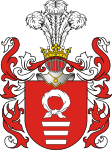 Coat of arms of Dybowski family
Coat of arms of Dybowski family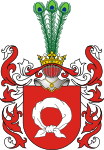 Coat of arms of Felsztyński family (1780)
Coat of arms of Felsztyński family (1780) Coat of arms of Gostomski family
Coat of arms of Gostomski family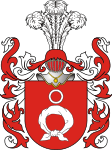 Coat of arms of Korth vel Kort family
Coat of arms of Korth vel Kort family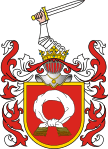 Coat of arms of Kunowski family
Coat of arms of Kunowski family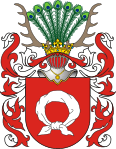 Coat of arms of Mikołaj Łączyński, 1580
Coat of arms of Mikołaj Łączyński, 1580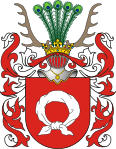 Coat of arms of Dobrogost Miliński, 1570
Coat of arms of Dobrogost Miliński, 1570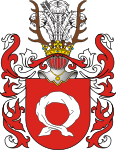 Coat of arms of Gołyszewski and Morawski family
Coat of arms of Gołyszewski and Morawski family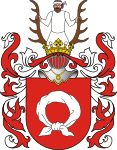 Nałęcz II
Nałęcz II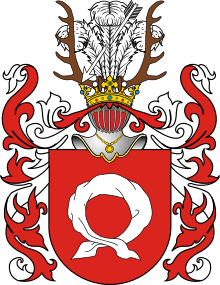 Nałęcz III
Nałęcz III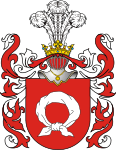 Nałęcz IV
Nałęcz IV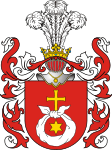 Nałęcz V
Nałęcz V Coat of arms of Andrzej Strykowski, 1565 and Jan and Stanisła Niczów, 1578
Coat of arms of Andrzej Strykowski, 1565 and Jan and Stanisła Niczów, 1578 Coat of arms of Nowosielecki family
Coat of arms of Nowosielecki family Coat of arms of Odachowski family
Coat of arms of Odachowski family Coat of arms of Counts Ostroróg
Coat of arms of Counts Ostroróg Coat of arms of Tomasz Pirawski, 17th century
Coat of arms of Tomasz Pirawski, 17th century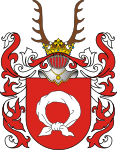 Coat of arms of Łukasz Raczkowski, 1591
Coat of arms of Łukasz Raczkowski, 1591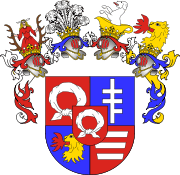 Coat of arms of Rostworowski family
Coat of arms of Rostworowski family Coat of arms of Szawłowski family
Coat of arms of Szawłowski family Coat of arms of Tański family
Coat of arms of Tański family Coat of arms of Jan Węgier, 1613
Coat of arms of Jan Węgier, 1613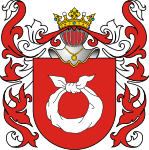 Coat of arms of Woropaj family
Coat of arms of Woropaj family Coat of arms of Maciej Żądłowski, 1565
Coat of arms of Maciej Żądłowski, 1565 Coat of arms of Żychliński family.
Coat of arms of Żychliński family.
Aristocratic variations
 Coat of arms of Counts Gorzeński family
Coat of arms of Counts Gorzeński family Coat of arms of Counts Kęszycki, Łączyński and Małachowski
Coat of arms of Counts Kęszycki, Łączyński and Małachowski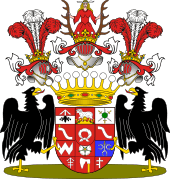 Coat of arms of Count Stanisław Małachowski
Coat of arms of Count Stanisław Małachowski Coat of arms of Counts Moszczeński
Coat of arms of Counts Moszczeński Coat of arms of Counts Moszczeński.
Coat of arms of Counts Moszczeński.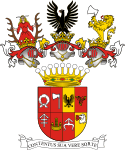 Coat of arms of Counts Ostrorog
Coat of arms of Counts Ostrorog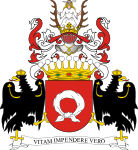 Coat of arms of Counts Raczyński
Coat of arms of Counts Raczyński
Other
- Nałecz coat of arms of Stanisław Slawieński in his burial monument inside Gniezno Cathedral (circa 1661)
- Nałęcz coat of arms of Kazimierz Raczyński, detail of Guardhouse in Poznań
 The Nałęcz Flag
The Nałęcz Flag.svg.png) Medieval version of Nałecz coat of arms according to the Gelre Armorial
Medieval version of Nałecz coat of arms according to the Gelre Armorial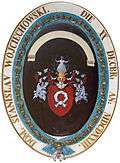 Coat of arms of the Polish President Stanisław Wojciechowski as Knight of the Order of the Elephant (1923). The Chapel of the Order of the Elephant, Frederiksborg Castle, Hillerød (Denmark).
Coat of arms of the Polish President Stanisław Wojciechowski as Knight of the Order of the Elephant (1923). The Chapel of the Order of the Elephant, Frederiksborg Castle, Hillerød (Denmark).- Dobrogost z Nowego Dworu, Archbishop of Gniezno
 Armorial Toison d'Or
Armorial Toison d'Or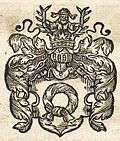 Nałęcz coat of arms by Bartłomiej Paprocki published in "Gniazdo cnoty.." (1578)
Nałęcz coat of arms by Bartłomiej Paprocki published in "Gniazdo cnoty.." (1578)
See also
Bibliography
- Juliusz Karol Ostrowski: Księga herbowa rodów polskich. T. 1-2. Warszawa: Główny skład księgarnia antykwarska B. Bolcewicza, 1897.
- Adam Boniecki: Herbarz polski. Warszawa: skł. gł. Gebethner i Wolff, 1899.
- Franciszek Piekosiński: Heraldyka polska wieków średnich. Kraków: Akademia Umiejętności, 1899.
- Józef Szymański: Herbarz średniowiecznego rycerstwa polskiego. Warszawa: PWN, 1993. ISBN 83-01-09797-3.
- Anna Wajs: Materiały genealogiczne, nobilitacje, indygenaty w zbiorach Archiwum Głównego Akt Dawnych w Warszawie. Warszawa: DiG, 2001. ISBN 83-7181-173-X.
- Alfred Znamierowski: Herbarz rodowy. Warszawa: Świat Książki, 2004. ISBN 83-7391-166-9.
- Tadeusz Gajl: Herbarz polski od średniowiecza do XX wieku : ponad 4500 herbów szlacheckich 37 tysięcy nazwisk 55 tysięcy rodów. L&L, 2007. ISBN 978-83-60597-10-1.
References
- ↑ Not mentioned in the works of Tadeusz Gajl.

